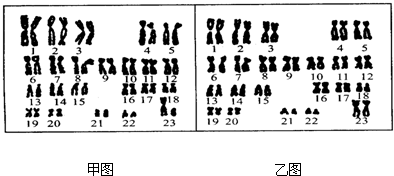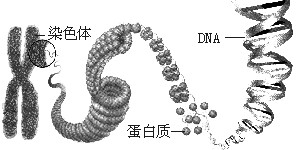问题
解答题
下列是男女成对染色体排序图.

请分析作答:
(1)显示为男性的是哪幅图?
(2)决定女性性别的基因位于哪一对染色体上?
(3)组成染色体的物质是什么?
答案
(1)分析图示可知:甲图中的第23对染色体一条大、一条小,为XY染色体,因此甲图表示男性的体细胞中的染色体的组成;乙图中的第23对染色体形态大小基本相同,是XX染色体,即乙图表示的是女性体细胞中的染色体的组成.
(2)人类体细胞内染色体分为常染色体和性染色体.常染色体就是对性别决定不起直接作用,除了性染色体外的所有染色体.例如,人类有22对常染色体,1对性染色体.人类正常染色体为46条(23对),其中22对称为常染色体,男女都一样;第23对称为性染色体,人的性别主要是由性染色体决定的,男性体细胞中的一对性染色体组成是XY,女性体细胞中的一对性染色体组成是XX.因此决定女性性别的基因位于XX染色体(或第23对染色体).
(3)染色体是细胞内具有遗传性质的物体,易被碱性染料染成深色,所以叫染色体(染色质);染色体是细胞核中载有遗传信息(基因)的物质,主要由脱氧核糖核酸(DNA)和蛋白质组成,如图

每一种生物细胞内染色体的形态和数目是一定的,染色体数目的恒定对生物正常的生活和传种接代是非常重要的.DNA的结构像一个螺旋形的梯子,DNA上具有遗传效应的片段是基因.
故答案为:
(1)甲图;
(2)XX染色体(或第23对染色体);
(3)DNA和蛋白质.
